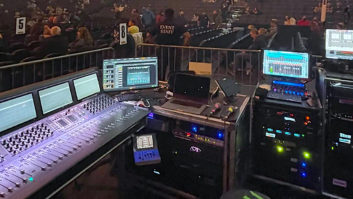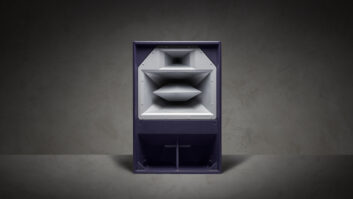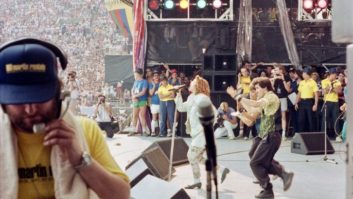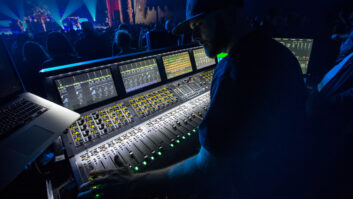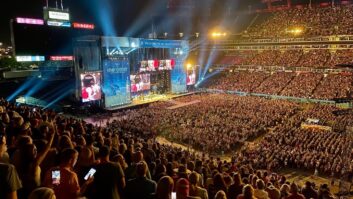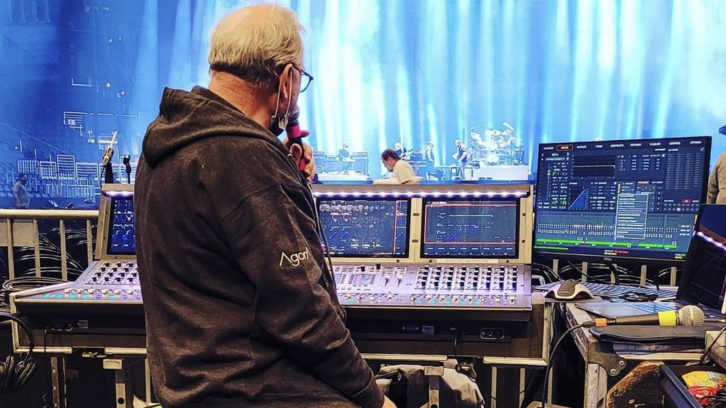
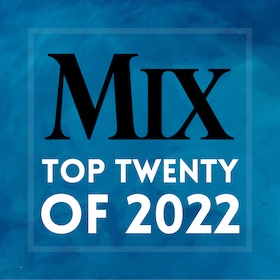 This was Mix’s 8th most-read article of 2022!
This was Mix’s 8th most-read article of 2022!
As the final Genesis world tour edges towards its conclusion in March, 2022, we continue talking with the band’s longtime FOH engineer Michel Colin about the gear he uses nightly, Phil Collins’ surprising vocal microphone, and how to get that classic 1980s gated drum sound live. Also, don’t pass up Part 1!
Despite all the plug-ins on-hand to provide all kinds of sounds and effects, there’s one crucial element that is still handled by outboard gear: the trademark 1980s drum sound that’s heard across the band’s biggest hits. Due to health issues, Collins doesn’t play drums these days and focuses on singing; instead, the role has been passed on to his son, Nic, who proves nightly that he’s a considerable technical drummer following in his father’s footsteps. To achieve that classic, massive drum sound, Colin doesn’t turn to a plug-in emulation, opting to instead use the real deal, sitting nearby in a rack: “It’s the tc electronic M6000, which I’ve used for the last 20 years on every show. It has very good reverbs—but the most important part is that they have this famous reverb, like an AMS RMS16 Non-Lin 2 gated reverb, to emulate the Eighties drum sound.”
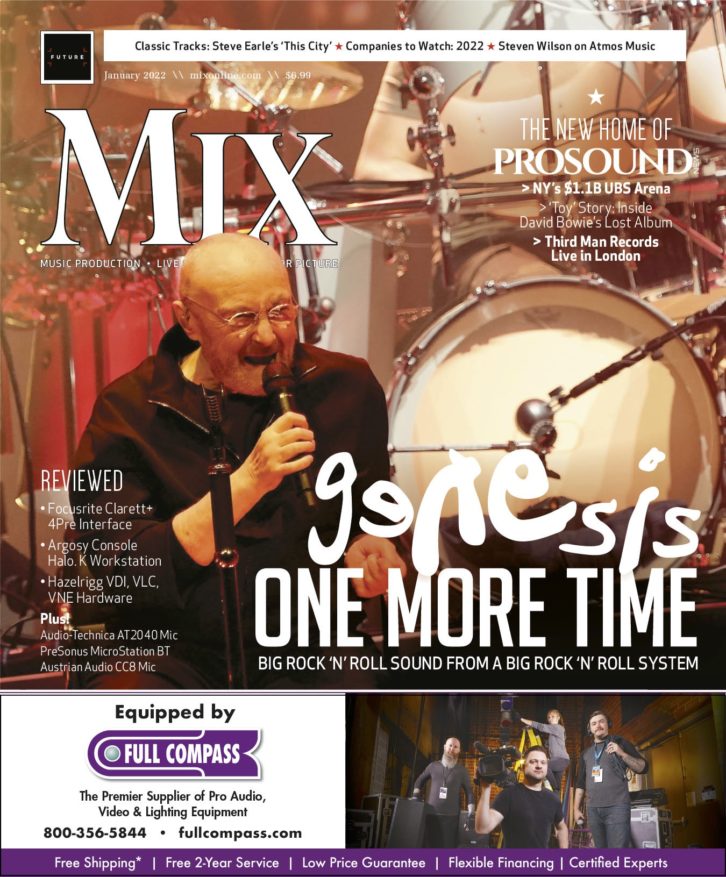
The tour’s 62 inputs stem from the main drum set and a secondary, smaller kit used for a more intimate acoustic set, while Rutherford and guitar accompanist Daryl Stuermer trade off bass and guitar duties throughout the show, and backing vocalists Daniel Pearce and Patrick Smyth also provide occasional additional percussion. “Tony Banks makes his own keyboard premix,” said Colin, “so I really only have the guitars, bass and some loops coming from a laptop onstage, because the loops are a very important part of that kind of music.”
Miking across the stage is handled with a variety of options from different manufacturers. The drum kits are outfitted with familiar industry standards, with a Shure Beta 52A for the bass drum, bolstered by a Beta 91A inside. Shure 57s capture the snares top and bottom, while there’s a Neumann KM 84 on hi-hat, Sennheiser e 904 on toms and Audio-Technica 4050s for overheads.
When it comes to the guitars on stage, a Yamaha Subkick can be found in front of one of the bass amplifiers, but Michel Colin noted that in addition to various Radial DIs onstage, “I’m still using Klark-Teknik DIs on the bass guitar, because for me, it’s the best—very transparent and very powerful. On Daryl’s guitar is the Audio-Technica AT 4040, while for Mike Rutherford, I use a 57 and a 4040 together—I use both on the same channel, so its two channels but a mono feed; I have to address the mic together but it’s working really well.”
A total of eight Shure Axient Digital microphones are onstage, with four on guitars and four capturing vocals, with DPA d:facto capsules used for the backing singers while Collins’ lead vocal is handled differently. “For Phil, I use an sE electronics V7—100 bucks a capsule,” Colin laughed. “During the ‘Not Dead Yet’ tour with Phil, I tried many, many microphones. We started with the Shure KSM8, then I changed that out for a DPA d:facto, then I tried some other microphones, but I was not very happy. One day, I tried this one; I thought, ‘Oh, why not?’ It was the cheapest you can get and it looks a bit red onstage, because the foam inside is red, but for Phil, it fits perfectly with his voice and it has good rejection because I have Nic’s drums right behind him. I like the tonality, the rejection of the noise around—and the feedback sensitivity is important. Sometimes we get feedback from Phil’s in-ears because they are so loud! If I see him move his mic near his ears, I clamp down the fader.”
Like everyone else on stage, Collins wears Shure PSM 1000 in-ear monitors, with mixes coming from the Avid S6L manned at stageside by Alain Schneebeli, Collins’ monitor engineer for nearly three decades. A d&b audiotechnik V Sub acts as a drum sub, and otherwise it’s a moderately quiet stage.
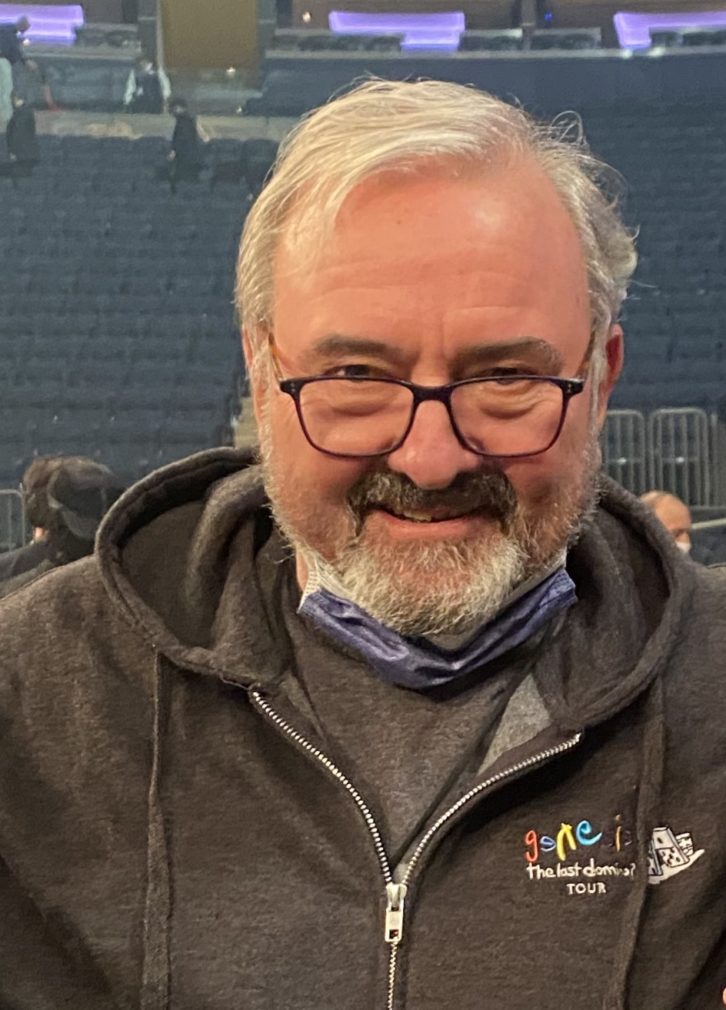
Up above it all is the tour’s L-Acoustics system, which for the U.S. leg was provided—much like all the audio production—by Miami, FL-based Unreal Systems/Agora USA. A rising presence in that state’s event production scene, Unreal saw the Genesis tour as “an opportunity to showcase our large-scale capabilities,” said Andre Serafini, captain at Unreal. “The connection with the Genesis camp stems from my relationship that started from my time founding and building Beachsound here in Florida, and I’m fortunate that Genesis evolved with me over the past years after that company’s sale. Joe Williams and Gabriel Martin Santana are Unreal’s system engineers out on the tour, and Neil Rosenstock, who was a legacy Beachsound pro, was brought in to crew chief the audio team under the direction of Ben Philips, the tour’s audio system designer.”
Much as on Phil Collins’ solo tours, L-Acoustics is the P.A. of choice, but it’s deployed with shorter mains and sidefills, not to mention multiple layers of delay hangs in order to accommodate Genesis’ extensive use of lighting and video elements. Philips explained, “It’s a very heavy show with all the automation, lighting, video and everything else, so we had to avoid adding much weight over the stage. We reduced the size of the main and outfill arrays for that reason, and also because we couldn’t have huge arrays since there’s quite a lot of audience lighting. Additionally, there’s a pair of 40-meter trusses directly in line with the main arrays—we can’t shoot through that amount of truss and still cover the audience properly, so we opted for delay hangs well outside of that truss to make up for the coverage. On paper, it looks like a lot, but the number of boxes is similar to what you might typically see in an arena; we’ve just redistributed it throughout the room and spread the weight rather than concentrating it all over the stage.”
As a result, the main hangs are each a dozen K1s, supplemented on the sides by outfill hangs of 10 K1s and three K2s. For shows where seating is 270 degrees, there’s also rear hangs of 18 Kara boxes per side. Flown above center stage are a hang of two A15 wide boxes and a separate flown hang of nine KS28 subs, cardioid. In front of the stage sit an additional two-dozen cardioid KS28 subs, as well as eight A15s, four A10s and four X8s for fills. Above the audience, where the trusses hang, are delays of two A10s per side; next, halfway down the arena, are the inner delay hangs, each with eight K1s and three Kara boxes, and the far side of the arena gets outer delay hangs of eight K1s each. Powering all that are LA12x amplifiers and LS10 AVB switches, flown with each array. A total of five P1 AVB processors are used for system EQ, signal distribution and system optimization.
“Genesis” may mean beginning, but its antonym is “Terminus”—a fitting word as the band’s final tour literally reaches the end of the road. All that’s left are a handful of early spring makeup dates, culminating at London’s O2 Arena. “The London shows were postponed,” said Colin. “They still have to do London, so that’s why we have a little leg in March. They want to finish in their country and to say ‘bye-bye’ properly. It’s better to do that in London—and I think after that, it will be done.”


